The owners of private houses most often have to independently equip local treatment facilities on their site. The cheapest way in this case is to install sewer wells in the form of a conventional cesspool or a sealed storage tank. In the construction of both options, you can use different building materials. You can always choose the most optimal for the price and effort.
Often, there is simply no centralized sewerage system in the private sector with low-rise buildings. And household waste must be disposed of, not poured onto the ground. For this purpose, an autonomous sewage system is being built, including the inner and outer parts.
The internal sewerage system collects effluents from plumbing fixtures, and its outer part is intended for their disposal or accumulation for the purpose of subsequent pumping out by sewers. The street receiving well is the end point of this entire local treatment system.
If there is no general sewerage network in the village, then one cannot do without a cesspool or sewage storage near a private house
Fecal effluents in the sewer well are clarified, resulting in the formation of partially purified water and suspensions. In case of cesspool the first is drained into the ground, and the second is decomposed by microorganisms to a state of biologically safe sludge. If the option with a storage tank is chosen, then sewage is simply collected in an airtight container, and as it is filled, they are pumped out with the involvement of a sewage machine.
Of course, you can install a full-fledged septic tank with several cleaning chambers, but it costs a lot. For a small cottage or dacha, where a family of three or four people lives, a storage tank or cesspool of several hundred liters in volume is quite enough. There are not so many drains, such a disposal system will cope with sewage without problems.
Image Gallery
![]()
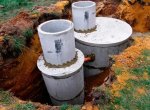
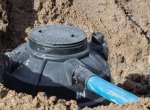
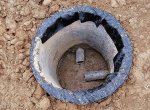
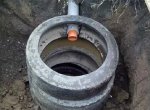
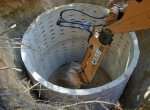
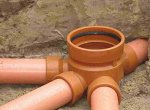
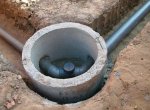
Fermentation and clarification Wastewater can be produced in one or more tanks connected in series. However, in the second case, the installation of sewer wells is greatly complicated. It is easier to equip one well structure, and to speed up the purification processes, pour chemical or biological reagents into it.
Most often, on the adjacent plot, on their own, the owners of private houses do cesspool. But if the groundwater level is high, then the cesspool option is not suitable, you have to install a storage tank. Moreover, its volume is selected large enough to reduce the number of calls for sewers.
The decomposition of the biological component of sewage in the cesspool occurs due to anaerobic microbes. They do not require oxygen replenishment for life, therefore, additional aerobic installations will not be required to be installed in the well. The entire cleaning system turns out to be non-volatile, not requiring connection to the mains.
All decay processes inside the sewer well occur naturally, thanks to bacteria living in the soil. In this matter, they are quite successful, but anaerobes “work” rather slowly. Therefore, in order to speed up the processes, bioactivators are occasionally added to the pit.
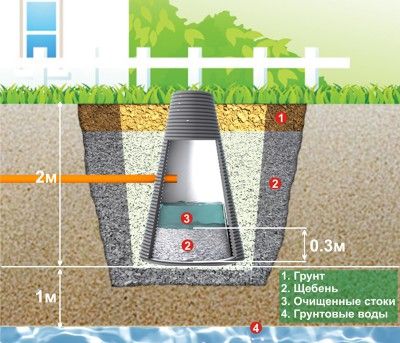
The distance between the draining bottom of the cesspool and the groundwater layer must be at least a meter, otherwise the purified water will have nowhere to go
Requirements for the construction of facilities for wastewater
All sewerage must be installed according to a pre-developed plan, which indicates the layout of all elements of the system and the building materials used. Its outer part in the case under consideration consists of a pipe draining from the house and treatment plant.
The design and installation of sewer wells is regulated by SP 55.13330.2011 “Single-apartment residential houses…” and SP 32.13330.2012 “Sewerage. External networks ... ". If you do not comply with the requirements specified in them, then the sewage system after assembly may simply be inoperative.
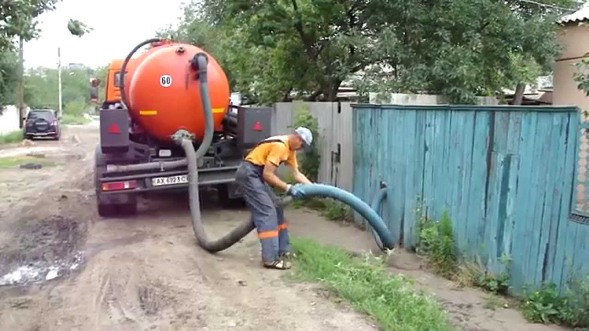
When choosing a place on the site for a treatment structure, one should not forget about the need to leave free access to it, even a draining cesspool must be cleaned from accumulated sludge from time to time
Structurally, the sewer well consists of:
- necks with a lid or hatch;
- shafts in the middle part (working chamber);
- bottom (draining or sealed, depending on the option chosen for installation).
Even the same type of elements of this design can vary greatly in size and shape. Much depends on the material of manufacture and design features treatment plant, as well as the volume of the tank.
What can you build a sewer well from?
The well construction can be made from a variety of building materials. When choosing the best option must be taken into account:
- Climatic conditions of the area (maximum possible and average temperatures, total amounts of rainwater and snow).
- Soil characteristics (freezing depth, composition and GWL).
- Features of the relief of the site.
If the soils are very heaving, then the sewerage well should be made of the most durable building materials. And for saturated with water soils will have to select the most moisture resistant option.
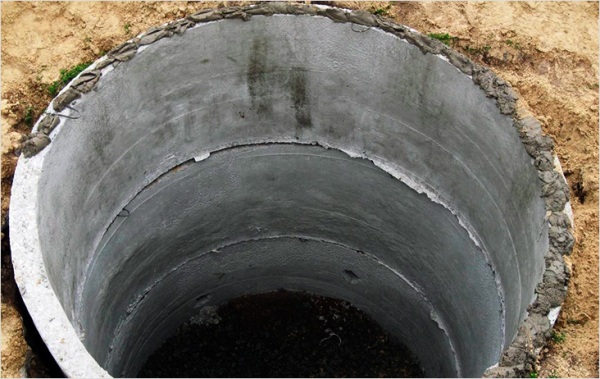
The most inexpensive and fastest to install is the construction of reinforced concrete rings, however, to install them in an excavated pit, you will need to order a crane
With your own hands, a sewer well can be easily made from:
- brick and stone;
- monolithic concrete;
- reinforced concrete rings;
- prefabricated plastic structures
- old tires.
The cheapest at self-assembly a brick or structure made from factory concrete rings will cost. But in the first case, you will have to tinker with masonry, and in the second, you will need lifting equipment. Lowering heavy concrete products into the pit by hand is not recommended; strong blow they can collapse.
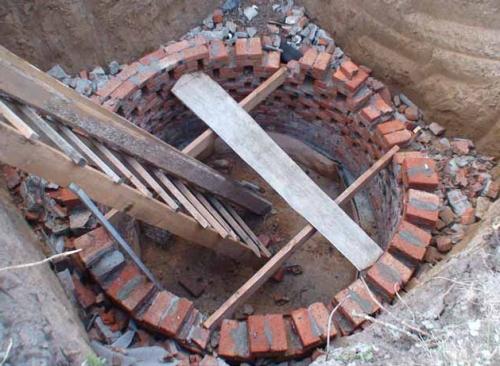
It will be possible to make only a sewer well with drainage from a brick, it is extremely difficult and expensive to ensure complete tightness of brick walls
A concrete structure will require formwork and mortar preparation. If the latter is ordered already mixed in a concrete mixer, this will lead to a serious increase in the cost of work.
Structures made of plastic (polyethylene or PVC), fiberglass and polymer sand are quite expensive. But they are durable and extremely easy to install with your own hands. Such products weigh a little, a couple of people are enough for their installation.
A very cheap sewer well will come out of used tires. They cost a penny in a tire shop, or you can collect tires in a landfill for free. But here the same problem as in the case of a brick. It is extremely problematic to make such a structure airtight, and it is almost impossible to repair it. It is possible to arrange a cesspool of them, but the drive is no longer there.
Image Gallery

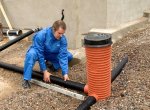
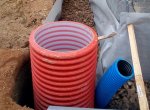
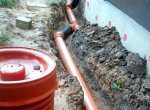
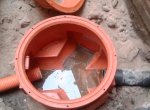
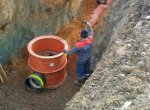
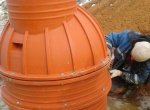
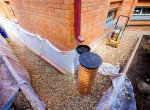
Choosing the location and volume of the tank
When installing a sewer well, observe whole line sanitary and building requirements. Failure to do so increases the risk of biological contamination. The situation can be brought to an outbreak of infections, which threatens the owner of the cottage with serious problems.
Installation of a sewer well should be carried out at a distance from:
- fruit-bearing trees and beds of 3 m;
- foundations of buildings on personal plot at 4–5 m;
- roads and underground engineering communications(gas, water, electricity) 5 m;
- wells for drinking water and reservoirs in 30 m.
A slight deviation from these figures is possible only when installing a sealed storage tank or when installing a cesspool with powerful concrete walls with a reliable external waterproofing. In the case of an absorption well, water that has passed a multi-layer filter of sand and gravel should fall into the underlying layers of the soil away from buildings, communications, drinking wells, all types of reservoirs and private pools.
Distances must be observed so as not to change the composition ground water for the worse, do not pollute water bodies with insufficient cleaning and do not wash out the underlying base from under building structures and engineering networks.
However, if the well structure for sewerage is removed too far from the house, then inspection (revision) wells will have to be arranged on the pipeline between them every 10–15 meters, which will lead to considerable additional expenses. But this will have to be done, otherwise, if the pipe is clogged, you will have to open the soil in order to clean it corny.
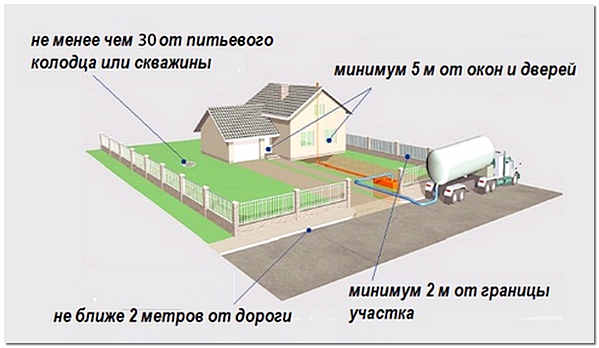
sewer well should be located away from the foundation of the house, roads and sources of drinking water, otherwise sewage breakdowns or outbreaks of infectious diseases are possible
The volume of the draining sewer well by SNiPs is recommended to be selected at the rate of 600 liters for each person permanently living in the house (200 daily liters of wastewater multiplied by three days). With such a capacity, the cesspool will have time to clarify the water, and the soil will receive purified water.
With storage capacity, the situation is somewhat different. It should be large enough so that there is a gap of a couple of months between calls by the sewer. However, it is also not worth installing an overly capacious tank. The best option would be a little more than 3.5 or 5 cubic meters. Drains from such a container completely fill the barrel of the sewage truck. You have to pay for the call, not the cubic capacity.
How to install a sewer well
When constructing a well structure outdoor sewerage necessary:
- Dig a pit with width dimensions 30–40 cm wider than the chosen design.
- Tamp at the bottom of the pit a sand and gravel cushion of 15–20 cm.
- Mount the elements of the well.
- Lay and connect the sewer pipe from the house.
- Perform a joint leak test.
- Install the ventilation stack.
- Backfill and insulate.
outdoor sewage pipe can be plastic, cast iron, ceramic or asbestos-cement. It should be laid at a slight slope to the well. Drains should flow into it unhindered by gravity. And the less the pipeline will have bends in the horizontal plane, the better.
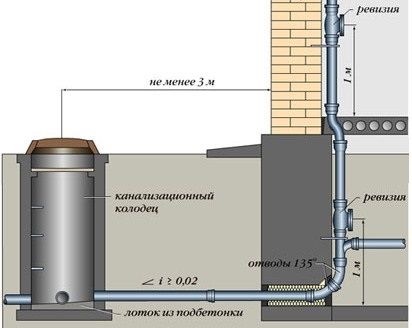
Installation of sewer pipes with a diameter of 110 mm is recommended to be done with a slope towards the well of 20 mm / per running meter, and with a cross section of 160 mm - 8 mm / running meter
Pipe products made of cast iron and asbestos cement have rough walls, their slope must be slightly increased. In general, only a highly competent engineer can correctly calculate the required diameter and slope of the pipelines to be laid. It is necessary to take into account the material of the pipes, the volume of wastewater and the speed of their movement. The best design of the entire project sewer system entrust to a professional, and then installation can already be done by hand.
The installation of the sewer well should be carried out in such a way that its cover rises 15–30 cm above the ground. In the event of rains and floods, water should under no circumstances enter the tank from the outside. This will instantly lead to its overflow and failure.
As insulation in warm regions, soil half a meter thick is enough over the main body of the well and a small layer of thermal insulation on the lid. In the northern regions, this will not be enough, you will have to cover the entire engineering structure with foam. He is not afraid of moisture and frost.
Option #1: Construction of concrete rings
The sewer well made of concrete is easy to install and unpretentious in operation. It is only necessary to carefully seal the seams between the rings with concrete mortar, as well as cover the walls of the housing from the outside with a coating based on bitumen.
Image Gallery
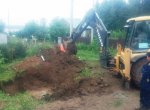
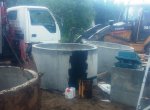
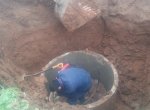
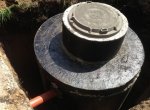
The main thing during installation is to make the rings on top of each other exactly without displacement. Otherwise, gaps form in the walls, which can no longer be hermetically closed. A pit for a cesspool can be dug immediately to the full depth and then the rings are lowered into it. And a variant is possible with the installation of one of the concrete products first and the production of a gradual undermining under it, while being inside the resulting mine.
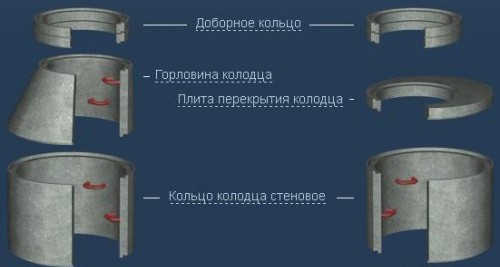
The depth of the sewer well is determined by the number of reinforced concrete rings and additional elements of the neck, having standardized dimensions from 0.7 to 2 meters
When arranging an absorption well to form a drainage layer, gravel is poured inside with a layer of about half a meter of crushed granite. You can take lime (dolomite) stone, but it will last no more than 20 years and can lead to soil salinization. Crushed stone should be of medium size, a few centimeters. Smaller fractions are simply compressed, ceasing to drain water.
Option #2: Tire drain pit
Car tires made of rubber are not subject to corrosion, do not crack in the cold and do not break when the soil is heaving. They make an excellent cesspool. But before you make a sewer well out of tires, you should seriously think about it.
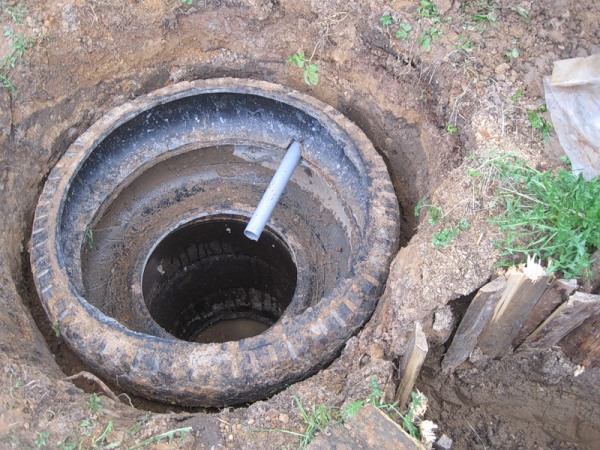
A cesspool made from old tires is cheap and easy to install, but leaky and completely unsuitable for repair.
If at least one of the tires leaks, you will have to dig out the entire well structure and shift it again. It cannot be replaced or repaired in any way. Plus, it is impossible to ensure the tightness of the seams between the tires. Various sealants can be used, but due to thermal expansion, the rubber will still “breathe” slightly during the year, destroying the sealing layer.
Such a well design is suitable as a sewer for small house for one or two people or cottages with occasional visits. But if you want to clean the effluents produced by a larger family, then you should choose a more productive and larger facility.
Option #3: Plastic Construction
The easiest way is to install factory-made plastic containers. Their price is higher than that of the reinforced concrete counterpart. But on the other hand, how much time and effort can be saved on installing such a sewer well with your own hands. Due to the low weight of the structure, the crane is not required, it can be lowered into the pit by two people.
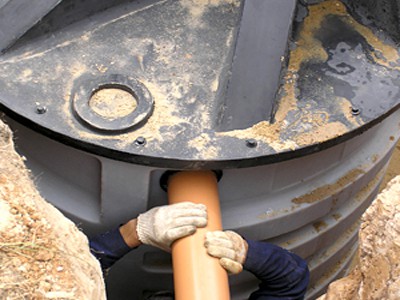
Pipes are inserted into the plastic well through holes already cut at the factory using rubber cuffs, installation is quick and easy
Plastic sewer wells are available in various sizes and heights. You can always find an option for the desired volume. It is better to choose a case with stiffeners and reliable fasteners for a concrete “anchor” under it.
If the plastic well is not securely fixed at the bottom of the pit on a concrete base, then it can be squeezed out of the soil during heaving and floods. The lightness of the design makes it easy to install, but leads to problems with “floating”.
If a sealed version is mounted, then there are zero problems. It will only be necessary to pour a concrete slab 15-20 cm thick at the bottom of the pit, laying iron hooks in the solution for attaching the hull.
But when installing a well with drainage in place of the bottom, you will have to tinker. It will be necessary to make a reliable heavy base that would not block the access of drained water to the ground. You will have to install an additional concrete ring down or pour something similar with your own hands.
Video instructions for self-assembly
How to make a cesspool out of tires on your own:
Stages of construction of a sewage well from concrete rings:
How to properly bond well rings from concrete:
You can make a sewer well on your own from different building materials with a minimum of effort and money spent. There are no difficulties here, the main thing is to correctly design the entire sewerage system and correctly select a place on the site for its external component. From above, the waste tank can be masked with a removable flower bed or an artificial boulder.
Today, few people will agree to live in a house that does not provide basic amenities. Therefore, when building a private house, cottage or cottage, you need to take care of the local sewage system.
And in order not to break out of the budget, it is worth building a sewer well with your own hands.
Where to begin?
Of course, before starting construction, it is necessary to draw up a detailed one. Only under this condition can you avoid mistakes and not do the same work several times.
At the initial stage of planning, the following activities are carried out:
- It is necessary to determine the location of the well for draining. It is better if it is a platform that is below the level of the house.
- Now you need to determine the point where the walking pod will leave the house.
- This is followed by the stage of drawing up a diagram on a scale with the designation of pipe sizes. In this case, you need to calculate the number of connections. The quality of the system depends on how accurate the measurements will be. In addition, at this stage it becomes clear what materials and in what quantities must be purchased.
Types of wells for sewer systems
Before you figure out how to make a sewer well, you need to find out what types of these structures will need to be included in the scheme.
The system may include wells of the following types:
- differential;
- Lookout;
- Turning;
- Cumulative;
- Filtration.
It often happens that one structure is built to simultaneously perform several functions.
As a rule, it consists of a working chamber and a neck covered with a hatch. What are the design features of certain types of these structures?
If the sewer pipeline is long enough, then you can not do without the equipment of manholes. Their functions are to ensure monitoring of the system and ease of cleaning in case of blockage.
Advice! According to the rules, the distance from the outlet of the sewer from the house to the first manhole should not exceed 12 meters. But closer than three meters from the foundation, it should not be placed. Subsequent manholes are placed at a distance of 15 meters from each other.
A rotary well is installed if it is impossible to ensure a straight pipeline. At the place where the pipe turns, a well is installed that can simultaneously be used as a viewing well.
Overflow well device for local sewerage system
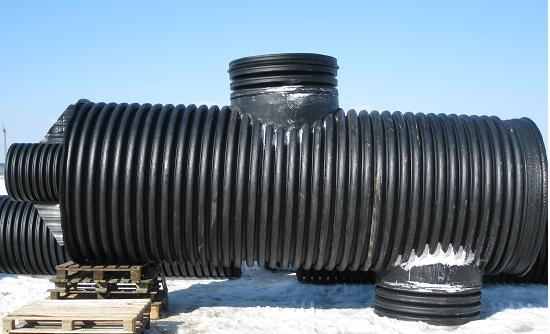
A drop well is necessary if, due to the natural topography of the site, it is impossible to produce with the required angle of inclination.
As a rule, the scheme of a sewer differential well differs from the usual one by the presence of a descent.
However, if the difference in the height of the pipes in such a well is less than 400 meters, then you can do without installing this additional part. The descent for the overflow well can be assembled independently.
It consists of a straight cross, pipe and elbow. If carried out, then the knee should be at 45 degrees, when applied cast iron pipes the required angle is 135 degrees. The descent is attached to the wall of the well with clamps.
Advice! The presence of a cross in the upper part of the descent is a prerequisite, since otherwise it will be very difficult to clean in the event of a blockage.
Drain well device
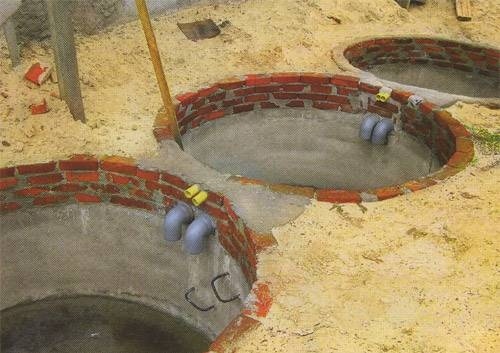
The drain well serves as a reservoir for the accumulation and primary treatment of wastewater. When choosing a place for its placement, it is imperative to adhere to sanitary rules, according to which the drain well is located at a distance of at least five meters from the foundation of the house.
As a rule, the sewer well scheme is a round or square tank, the bottom of which is filled with concrete.
It is extremely important to ensure that the bottom and walls of the tank are as tight as possible to prevent the penetration of raw sewage into the soil.
The simplest drain wells must be periodically cleaned of contents using a sewage machine. More advanced systems based on staged water purification (septic tanks) require cleaning much less frequently.
Sewer wells, as a rule, are made of brick, shoulder stone, concrete or reinforced concrete. In the latter case, it is convenient to use ready-made well rings.
The inner surfaces of a brick well are plastered with cement, and the bottom is covered with concrete. Outside, the well is insulated with a thick layer of greasy clay. The well cover is made of reinforced concrete. IN last resort, you can use boards made of tarred wood, covered with roofing paper.
Very often, the owners wonder how to sewer with reinforced concrete wells? Indeed, the use of ready-made well rings made of reinforced concrete significantly speeds up the construction process.
To build such a well, you first need to prepare the foundation. To do this, first a “cushion” is made of well-packed rubble, which is then poured with a solution.
Rings are installed on the finished base, depending on the depth of the well, from 3 to 5 pieces are required. To install the rings, it will be necessary to involve equipment, as they are quite heavy. To achieve tightness, the seams between the individual rings are coated with a solution.
Finished plastic wells
by the most simple option well arrangement is the installation of a finished plastic blank. Such wells were not previously used in Russia, since plastic could not withstand severe frosts. But with the invention of new types of plastic, this problem has been solved.
When choosing this option, the scheme of sewer wells will be extremely simple. Plastic tanks are available in different diameters and with ready-made holes for pipes.
The device of plastic wells is no different from the usual reinforced concrete ones. But installing them is much easier, since they have less weight and ready-made holes for pipes. While in reinforced concrete rings, these holes have to be punched with a special tool or manually.
Plastic wells have the following advantages:
- Tightness. This circumstance provides environmental safety the use of such products;
- Strength and resistance to aggressive environments;
- Ability to withstand temperatures from plus 70 to minus 50;
- Ease of installation and assembly.
Filter well device
last element autonomous system sewer is a filter well. It receives water that has passed preliminary degrees of purification in the first chambers of the septic tank.
When planning to build a filtering sewer well for a summer residence, you need to know that its device is similar to a storage device, but has its own characteristics.
So, when constructing the base of the well, concrete is not laid in a continuous layer, but along the perimeter of the shaft, leaving the soil in the center of the future well free. So the edge lower ring the well will rest on concrete base, and the bottom of the well will not prevent the penetration of water down.
For additional filtration, drainage holes are made in the lower compartment of the well, placing them at a distance of 50-100 mm from each other. During the construction of such a well made of bricks, gaps are left during masonry.
At the bottom of the well, a meter layer is covered with filter material - crushed stone, gravel, broken bricks. The same backfill is made outside along the perimeter at the bottom of the well. The inlet pipe is located at a height of 500 mm from the upper edge of the backfill, which is covered with a water-breaking board so that the falling jet does not erode the layer of filter material.
Advice! It is not necessary to cut the inlet pipe flush, otherwise the incoming water will flow along the wall, which will wash out the backfill. It is better to make this pipe protruding 50-80 mm into the well.
How to disguise a sewer well?
Of course, a sewer well for a summer residence is a necessary thing. However, it does not decorate the site in any way, especially since the place for its location is chosen not for reasons of beauty, but in accordance with building and sanitary standards.
As a result, it may turn out that the well will be in the most inappropriate place in the garden. However, it is not difficult to find a way out here - you just need to decorate the well, turning a disadvantage into a virtue.
The only condition is that when coming up with ways to decorate, you need to take into account that access to the well must be provided at any time. For the rest, you can rely on your imagination.
You can "cover" the well with ornamental shrubs, you can make a removable flower bed or install a light collapsible wire frame on top of the well, plant around climbing plants. You can put an artificial boulder on top of the hatch, since it is hollow inside, it will not be difficult to move it to another place if necessary.
So that the foundation of the house does not collapse due to the influence of moisture contained in the soil, it is imperative to make a drainage system. To save money, it is recommended to build a drainage well for sewage with your own hands or seek help from specialists.
What drainage wells exist?
Drainage wells can be:
- rotary;
- viewing;
- collector;
- absorbent.
Features of rotary wells
As a rule, during the operation of the sewer system, pollution occurs, which often accumulate in perforated pipes. To clean them, you will need to install rotary type wells. They are installed at pipe turns, with a pass through one. Thus, access to the inlet and outlet section of the pipe is provided.
Installation of concrete drainage well
The dimensions of such a structure will depend on whether a person needs access to the inside of the well in order to carry out repair actions. Thus, the approximate diameter of the well should be about one meter, only it will already be considered a viewing well.
Inspection type wells
Drainage viewing structures are made to control the operation of the sewer system. This design is different large sizes the mine, that is, it must be of sufficient size for easy access by a person who will monitor the condition of the sewer. If necessary, repair and maintenance work will be carried out.
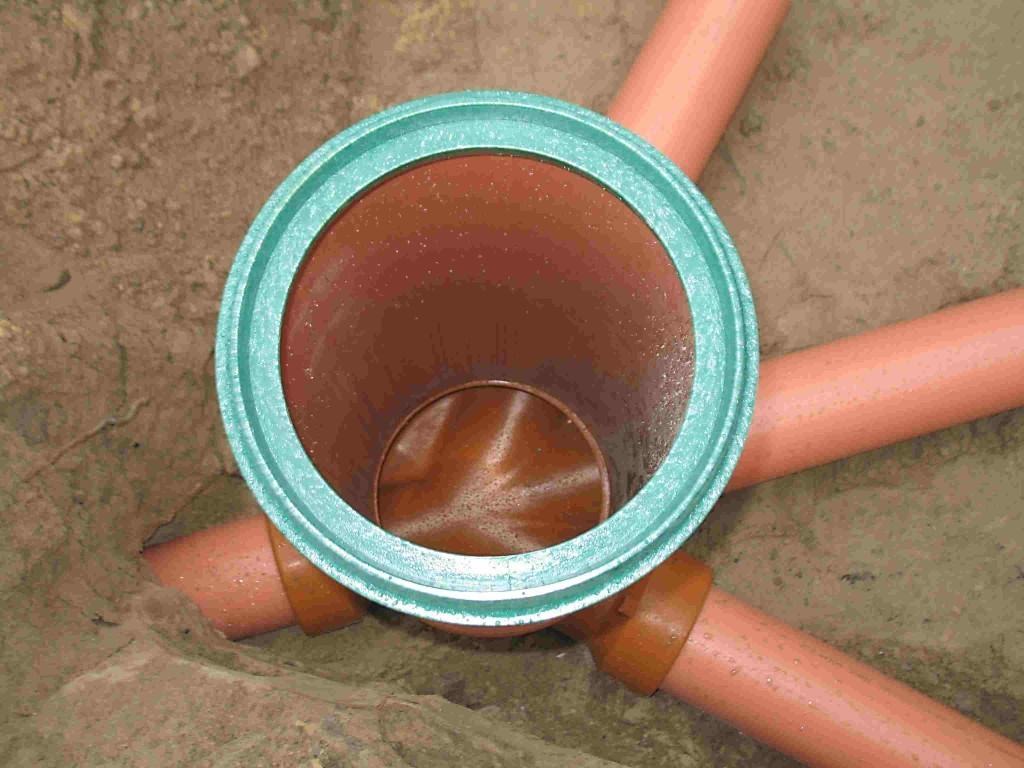 installation of a plastic drainage well
installation of a plastic drainage well A structure of this type is designed to perform several actions at once, it can also be a rotary one, since it is also installed at the point of convergence of several pipes or at their turning point.
Absorption type wells
These structures can also be called filtering, since they are most often mounted on the territory where there is a need to drain it, while there is no possibility of outputting currents to the general sewer system. In such cases, the depth of the wells will be approximately two meters.
For a device of this design, you must follow a certain technology:
- first, a hole of the required size is dug;
- a layer of gravel is laid on its bottom and a container is placed inside, it can be a pipe with a diameter of 50 cm;
- when this pipe is installed, they fall asleep in it broken brick, crushed stone, slag or gravel of a medium-sized fraction;
- around this filled structure, gravel is sprinkled;
- thus, a good and high-quality drainage reservoir is obtained. From above it must be covered with geotextile material and a layer of earth laid. As a result of these actions, a structure is obtained, with the help of which the natural drainage of effluents into the ground is carried out.
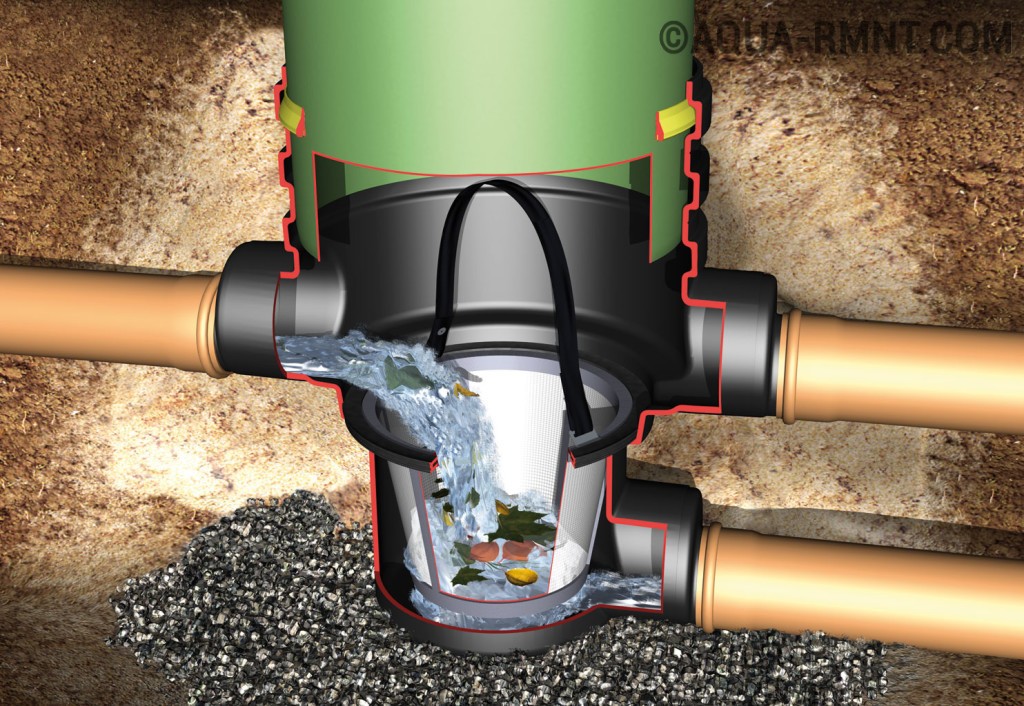 principle of operation of the absorption drainage well
principle of operation of the absorption drainage well Collector wells
Such structures can also be called water intakes, since this is the last compartment of a closed drainage system. In this well, water is collected and accumulated, which will later be pumped into a previously prepared recess, ditch or artificial reservoir.
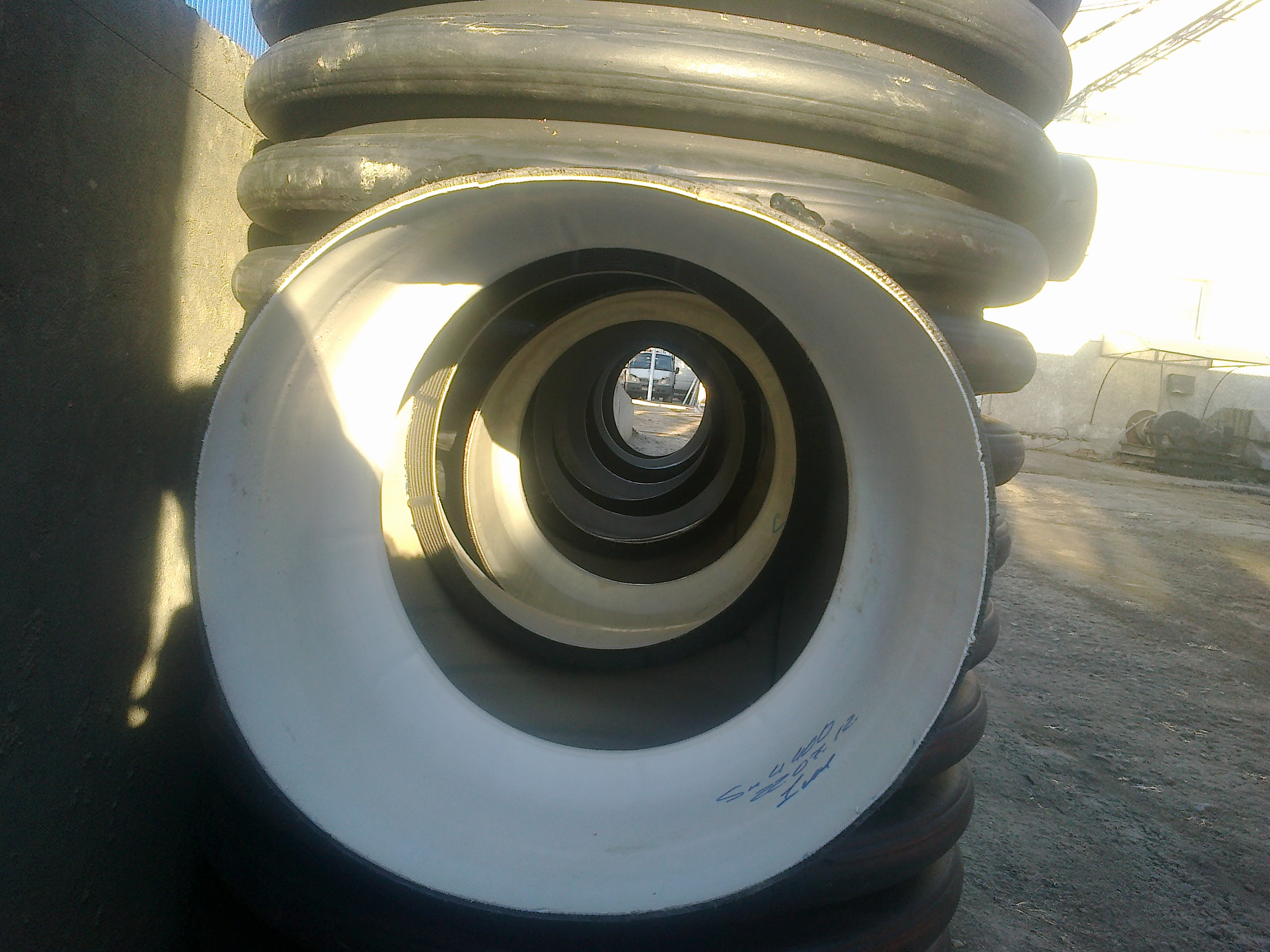 installation and selection of a collector well
installation and selection of a collector well Typically, such containers are constructed from ready-made sealed plastic wells, which are equipped with a waterproof bottom.
What materials may be required for a drainage structure?
Like pipes, drainage wells can differ in the material of manufacture and size. Most often, plastic or concrete is used for the production of such structures:
- to implement the second option, concrete rings are used, the height and diameter of which may be different. Installation of the structure is carried out in a pre-prepared pit, while the rings are lowered carefully with the help of special equipment. In this case, the main advantage will be the strength and durability of the structure, and the disadvantage is the complexity of installation work;
- now plastic analogues are successfully replacing concrete wells because they are easier and faster to install. Also, the advantages include low cost, low weight and the presence of all the required taps. Plastic drainage wells are not subject to corrosive damage and can successfully serve for at least 50 years. For high-quality and reliable pipe supply, rubber seals are used, which maintain tightness for decades. Since the use of a corrugated pipe is envisaged, the device will be securely fixed in the ground due to its stiffeners.
How to build a drainage tank?
Drainage structures in ready-made for the construction of a well are distinguished by ease of installation, reliability and good quality. The main disadvantage of finished wells is their high cost, in particular, this applies to products with a diameter of 800-1000 mm. In order to economize cash, you can build such a structure yourself.
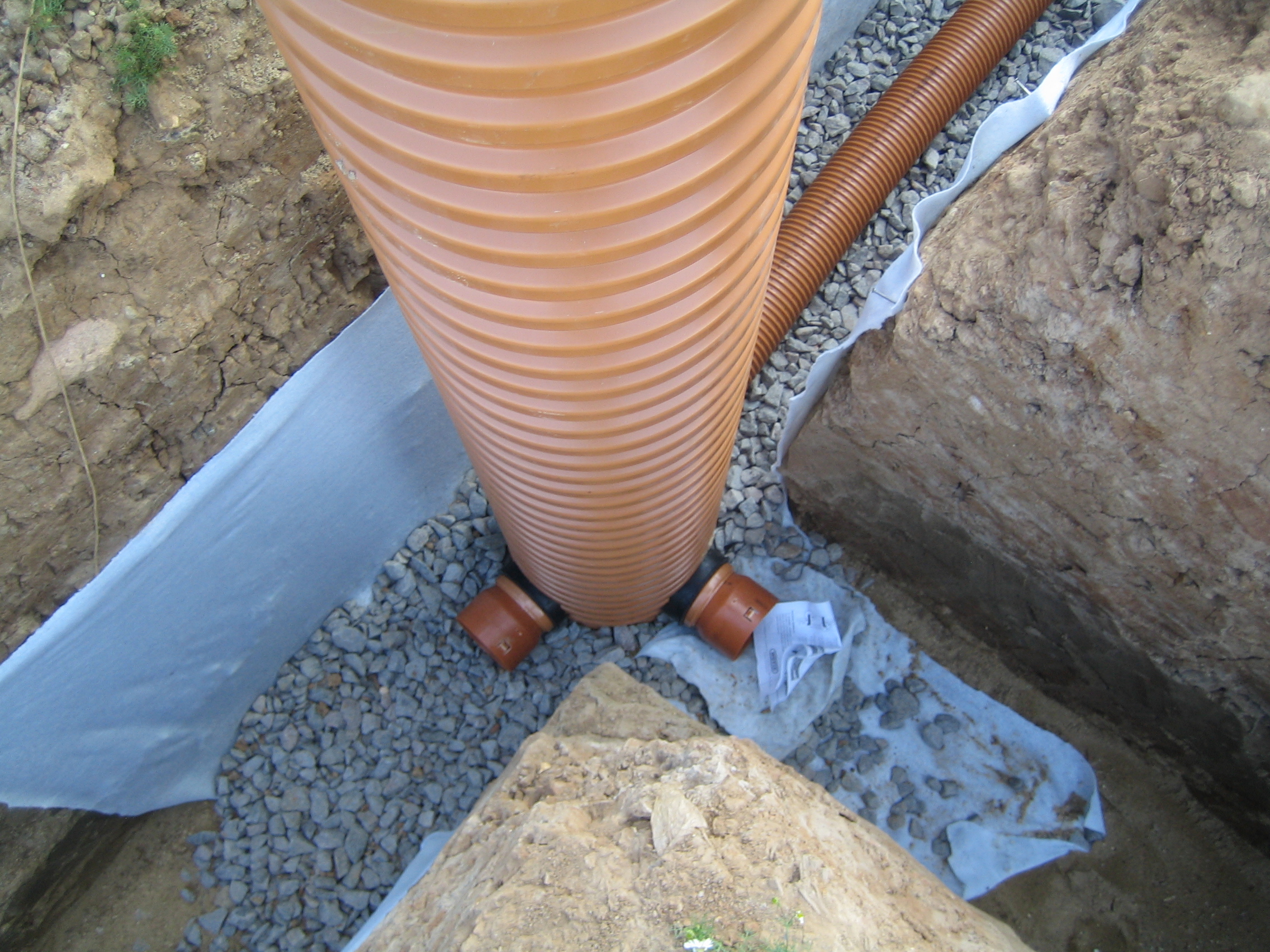 construction of a drainage reservoir
construction of a drainage reservoir For the manufacture of a drainage structure, it is required to acquire corrugated pipes of the appropriate diameter:
- for the construction of manholes, a pipe diameter of 340 mm or 460 mm is suitable, this is enough to ensure manual cleaning of the sewer system by means of water pressure from a hose;
- to make a storage or filter tank, you will need pipes with a diameter of 575 or 695 mm;
- if there is a need to periodically penetrate inside the well for repair and maintenance work, then you need to buy pipes with a diameter of 925 mm.
Except plastic corrugated pipes you also need to buy rubber seals of a suitable diameter, a hatch and plastic for the bottom device.
To save money, you can buy the components separately.
During the assembly and installation of the storage facility, a certain sequence should be observed:
- holes are cut in the well for connecting pipes and installing rubber seals;
- the bottom of the well is mounted. Experts recommend processing the bottom of the structure bituminous mastic, so the bottom of the well will be protected from leaks;
- using crushed stone and sand, you need to make a base in drainage ditch, after which it is poured with cement;
- a finished structure is installed on the prepared bottom. To prevent the risk of leakage of the structure, it is recommended to coat the connection points drainage pipes bituminous mastic;
- the tank is filled with crushed stone and sand, after which the tamping and laying of the base for the hatch device is carried out. The hatch is placed in a pre-prepared cement frame.
The presence of a hatch is a prerequisite, since it is necessary to clean the drainage system. The service life of a building depends on correct manufacture and installation of a well.
Well construction step by step
When all the materials have already been purchased and prepared, you can proceed with the installation work:
- First, the pipe must be cut to length, while taking into account the depth of the drainage well.
- It is necessary to cut holes for connecting pipes, retreating 50 cm from the bottom edge of the pipe. Rubber cuffs are inserted into these holes.
- The bottom of the well is fixed, while the docking site must be treated with a bitumen-based sealant.
- To install the well, you need to prepare a pit in advance, at the bottom of which cement mortar is poured.
- The structure can only be installed after the cement has completely hardened, after which drainage pipes are connected to it.
- The space formed between the walls of the pit and the structure must be covered with sand and gravel.
- A hatch is placed on top of the installed tank.
Features of the installation of plastic wells
As a rule, ready-made plastic structures are not cheap, so you won’t be able to save much. The only thing you can do is buy individual elements required size and diameter. So, you need to prepare:
- corrugated pipe of the appropriate diameter;
- plastic for bottom device;
- rubber seals. For the installation of a storage or filtration well, a pipe with a diameter of 695 or 575 mm is required.
In the process of installing a drainage well with your own hands, it is important to adhere to a certain algorithm:
- the corrugated pipe must be cut, taking into account the depth of the well. Next, it is required to make holes in it for connecting perforated pipes, which are connected using rubber seals;
- a ditch is dug, on the bottom of which a layer of gravel with sand is laid. After that, the building is poured cement mortar and covered with geotextile material;
- at the next stage, the bottom is installed, which is connected to the pipe, while the docking place must be treated with bituminous mastic;
- now it is possible to bring drainage pipes to the structure, and the joints should also be coated with a sealing compound;
- it is imperative to install a pump that will ensure the pumping of the collected water;
- the voids formed around the well must be covered with fine-grained gravel;
- on last step roof is being installed.
Summing up
A necessary part of the drainage system is the drainage tank. It is installed in order to monitor the operation of the entire system, it is also necessary to carry out repair and preventive measures.
To simplify the installation process of the structure, you can buy ready product, which will be expensive, but if this is not possible, you can build it yourself. For this, plastic pipes or concrete rings of the required diameter are used.
In fact, building a drainage structure is not as difficult as it seems at first glance. It is enough to purchase the necessary set of parts and adhere to a certain algorithm of actions.
An important part of the drainage system is the sewerage well. If sewer wells work well, then no one even thinks about their presence. However, as soon as the functions of the wells are violated, very big problems appear.
Sewer well
Although, at first glance, it seems that the installation of a sewer well is simple, because the design is quite simple, but professionals are required to work. If the installation of the sewer well is done incorrectly, this can lead to a negative result. In the end, you have to do everything all over again. Time goes by, but you still don't have a sewer well. Therefore, you need to contact professionals who have experience in this area, as well as necessary knowledge and skills.
We will do, that is, we produce everything necessary work for the construction, repair, and modernization of the well for sewerage. High professionalism allows us to make high-quality installation of sewer wells. We carry out all the necessary complex of works.
We pay special attention to the observance of the necessary technologies and quality of work. All stages of construction and sewerage comply with regulatory requirements. Thus, the long operation of sewer wells in private homes is guaranteed.
The price of a sewer well in Moscow
| Depth wells in rings | Price(work + ring for 1500 rubles) | Cost of work(your rings) |
| 1 | 4 500 rub. | 3 000 rub. |
| 2 | 9 000 rub. | 6 000 rub . |
| 3 | 13 500 rub. | 9 000 rub. |
| 4 | 18 000 rub. | 12 000 rub. |
| 5 | 22 500 rub. | 15 000 rub. |
| 6 | 30 000 rub. | 21 000 rub. |
| Full | ||








